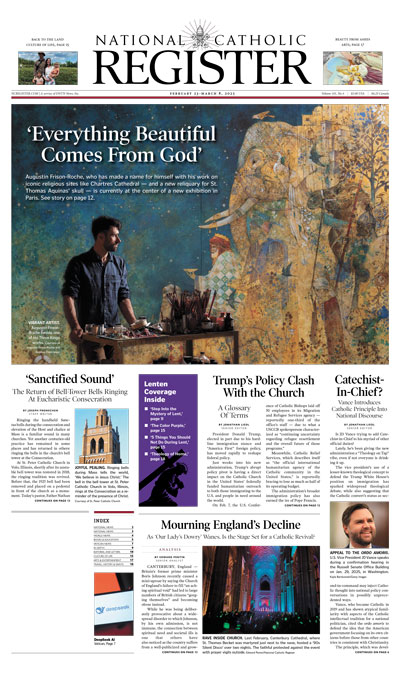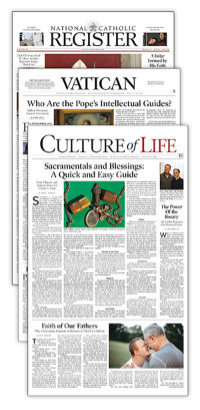‘Hail Glorious St. Patrick’: Honoring the Irish Saint
It is important to remember the real person who is the saintly inspiration for March 17 celebrations.

Of the many things associated with the feast day of Ireland’s patron saint, a small number originate with the religious day of observance.
There are now two St. Patrick’s Day days worldwide. One is an opportunity to celebrate and promote Ireland on the world stage, with all sorts of leprechaun-tinged Paddy-whackery, with everything from emerald-colored beer, floodlit prominent monuments in capital cities, and authentic Irish fare that no one on the Emerald Isle has ever actually tasted.
The other is the religious commemoration, grounded in the Catholic faith that celebrates St. Patrick’s conversion of the Irish, his missionary zeal and his pole position as patron saint of Ireland.
Father Owen Gorman, a priest in the Clogher Diocese in Ireland, pointed to these political, commercial and secular demands and observed, “The person who is really responsible for it all is really getting forgotten, St. Patrick, and his response to God and his life of faith. The dropping of the saint in connection to the day is a kind of a winning of the secular forces and, again, a diminution of the sacred identity and character of the day itself.”
Mass vs. Before Secular Celebrations
Father Gorman reflected, too, on the authentic traditional Catholic celebration. The day has always been about attendance at Mass and honoring of the national saint.
“There has always been this kind of tension on St Patrick’s Day between the sacred and the secular,” he explained. “When I was growing up, it was kind of like an easy tension, like one flowed into the other. The whole of the parish was out for morning Mass. This is, I suppose, the main way we would have celebrated St. Patrick’s Day. From the religious point of view, that St. Patrick’s Day Mass was a key aspect of the celebration of the day. We went to Mass, usually dressed with a bit of shamrock affixed to clothes, and we understood that as the symbol of the Trinity and the catechetical tool, which, according to legend, St. Patrick used to evangelize King Angus of Cashel. It was a religious aspect of living of the day, and the shamrock was blessed at the Mass.”
“A feature of Mass was the singing of the hymn Hail Glorious St. Patrick, which would not be sung liturgically, on, really, any other day of the year. It was a Mass at which there were clubs and societies, the sodalities, the scouts all represented, a very communal affair. It blended like an Irish stew. Our religious identity as Catholics, our cultural identity as Irish people, our faith, our ethnicity and all of these things kind of came together on the day itself. After the Mass, secular elements came to the fore. So there was always the local parade in the town and, afterwards, usually music and dancing and people off to the pubs and all of that.”
Now, Mass attendance has dropped off, with the priest observing the “struggle to be 50% full.”
Patron’s Prayers
St. Patrick’s Day provides a means to remember what it means to be Irish worldwide, but in Ireland, for the observant faithful, the legacy of St. Patrick remains each March 17.
Martina Purdy is a Catholic commentator who is also a guide at the St. Patrick Visitor Centre in Downpatrick.
“Some of the beautiful traditions really are about going to Mass and praying and remembering the authentic patron saint who lit a fire of faith, hope and love on this island, a flame that will never go out because it burns in the hearts of the Irish,” she said.
“One great tradition that we have found is that Christians gather at St. Patrick’s grave on St. Patrick’s Day, Christians from other denominations, and they pray together. And one of the things that started about three years ago, the clergy of different Christian faiths all get together and pray at the grave.”
“We, the laypeople, come together at dawn, at quarter to 6 in the morning on St. Patrick’s Day, at his grave, and pray 100 Our Fathers, and we recite the Breastplate of St. Patrick. That is a way of honoring Patrick and remembering and praying for the unity of all Christians.”
Father Gorman also refers to newer approaches, “There are new initiatives, such as the ‘Light the Fire’ initiative, the Franciscan Sisters of Renewal in Drogheda celebrate vespers and have prayers in the hill of Slane, in connection with St. Patrick. Many people now pray the St. Patrick’s Breastplate prayer, which is good.”
“And of course,” Purdy added, “we all love St. Patrick. It is a wonderful day of celebration, but at the heart of it really is the celebration of Patrick, the authentic Patrick, who carried the message of Christian love and forgiveness and eternal life.”
- Keywords:
- st. patrick
- st. patrick's day
- catholic saints















